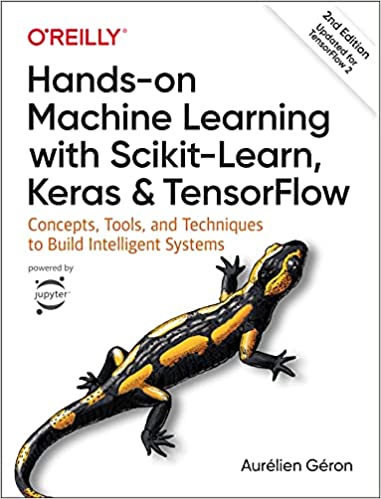Using concrete examples, a minimal theory, and two production-ready Python frameworks - Scikit-Learn and Tensor Flow - author Aurélien Géron helps you gain an intuitive understanding of the concepts and tools for building intelligent systems. You will learn a number of techniques, starting with simple linear regression and moving on to deep neural networks. With the exercises in each chapter to help you apply what you've learned, all you need is programming experience to get started.
Hands on machine learning with Scikit Learn Keras and Tensorflow
- Explore the machine learning landscape, particularly neural nets
- Use Scikit-Learn to track an example machine-learning project end-to-end
- Explore several training models, including support vector machines, decision trees, random forests, and ensemble methods
- Use the Tensor Flow library to build and train neural nets
- Dive into neural net architectures, including convolutional nets, recurrent nets, and deep reinforcement learning
- Learn techniques for training and scaling deep neural nets.
This book assumes that you know next to nothing about machine learning. Its purpose is to provide you with the concepts, tools, and intuition you need to implement programs that can learn from data. We'll cover a wide range of techniques, from the simplest and most commonly used (like linear regression) to some of the Deep Learning techniques that regularly win competitions.
Hands-on machine learning with Scikit Learn and Tensorflow PDF
Rather than implementing our own toy versions of each algorithm, we'll use production-ready Python frameworks:
- Scikit-Learn is very easy to use, but it implements many Machine Learning algorithms efficiently, so it is a great starting point for learning Machine Learning.
- TensorFlow is a more complex library for distributed numerical computation. It makes it possible to train and run very large neural networks efficiently by distributing calculations across hundreds of multi-GPU servers.
- TensorFlow is a more complex library for distributed numerical computing. This allows very large neural networks to be trained and run efficiently, distributing computation across potentially hundreds of servers with multiple GPUs. TensorFlow was created at Google and supports many of its large-scale applications. It has been open source since November 2015 and version 2.0 will be released in October 2019.
- Keras is a high-level deep learning API that makes it easy to train and run neural networks. It can run on top of TensorFlow, Theano, or Microsoft Cognitive Toolkit (formerly known as CNTK). TensorFlow comes with its own implementation of this API, called tf.keras, which provides support for some of the advanced features of TensorFlow (such as the ability to load data efficiently).



